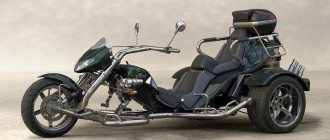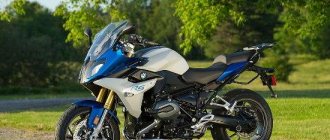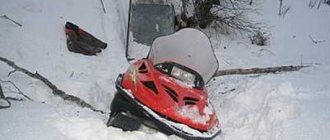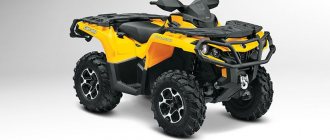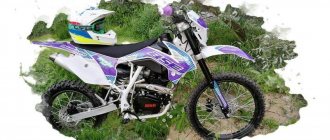- What is an ATV
- The structure of an ATV and the principle of its operation
- Features of BRP ATVs
- Types of ATVs
- Choosing an ATV for different operating conditions
- ATVs for beginners
- Criteria for selecting supported ATVs
- Infographics
All types of transport, except special equipment, can be divided into two large groups: road and off-road.
This applies to both cars and motorcycles. The difference between them is colossal, since some are created for movement on smooth asphalt roads, others are designed for operation in partial or complete off-road conditions with all the ensuing consequences. A popular off-road vehicle today is the ATV. Soggy mud, sandstones, clay, bumps, potholes and various types of unevenness are suitable conditions for riding an ATV. The growing demand for four-wheeled off-road motorcycles is explained by increased cross-country ability, ease of use, fuel economy and relatively inexpensive maintenance.
What is an ATV
An ATV is a four-wheeled vehicle belonging to the class of motor vehicles, designed for driving over rough terrain in partial or complete off-road conditions, but can also travel on dirt and asphalt roads. It has increased cross-country ability, is equipped with an engine with increased power and a predominantly automatic transmission (variator), less often a manual one.
In Western countries, the abbreviation “ATV” is added to the name of the ATV, which stands for “All Terrain Vehicle” (vehicle for all types of surface) or SSV - “Side-by-side Vehicle” (which in correct translation means “moving side by side”) side"). Versatility of operation is one of the main principles underlying the concept of creating off-road vehicles, also called all-terrain vehicles or all-terrain vehicles.
The ATV can also be ridden in the city, but technical parameters, including the engine structure, chassis with independent suspension and four wheels with large treads, indicate that the ATV was originally created for off-road driving. Therefore, buying such equipment for moving in the city is an idea devoid of meaning and logic. Unless we are talking about sports models designed for driving mainly on flat surfaces.
Varieties of modifications of ATV equipment
The range of modern manufacturers is represented not only by powerful units that have an engine capacity of more than 1000 cubic centimeters. Manufacturers have developed compact ATVs that are made specifically for children. As an additional useful functionality, they can be equipped with remote control. This allows parents to fully control the travel process and limit the speed if necessary.
Also in the line of equipment collections are sports modifications that are interesting for their attractive, stylish and creative design, as well as lightness. Their distinctive feature is their increased power engine and specialized transmission, which allows them to reach speeds of up to 160 km per hour. Today, an ATV is one of the most popular types of ATV, so sports and utilitarian modifications have been in significant demand among buyers in recent years.
The structure of an ATV and the principle of its operation
The technical structure of all-terrain vehicles is standard and understandable to anyone who has at least a little understanding of the internal structure of cars and motorcycles.
- Most models are equipped with four-stroke engines with different capacities - 100 to 1000 cc. see. Depends on the class of equipment and the expected direction of operation. ATVs are equipped with both diesel and gasoline engines, depending on the area of operation of the motorcycle.
- ATVs, due to their operational features, are often equipped with automatic transmissions or CVTs operating in high or low gear positions. However, models are also produced with a manual transmission, but there are fewer of them, since manual gear shifting is impractical when driving off-road.
- The system that transmits torque to the wheels can be cardan or chain. ATVs designed for driving on difficult terrain are equipped with cardan drives, which makes them more reliable, but adds weight to the equipment. Chain drives are installed on sports and universal (utilitarian) all-terrain vehicles.
- Due to the fact that ATV and SSV equipment is designed for operation in difficult, sometimes extreme conditions, it is subject to increased demands on the suspension. Most models are equipped with a suspension system, which consists of two levers, a pendulum suspension on the rear axle, a front shock absorber and a hydraulic shock absorber. Models designed for use in difficult conditions have independent suspension with hydraulics on each wheel.
- The cooling system can be air or liquid. The air system is easier to maintain and copes with the engine cooling function at medium loads. The liquid cooling system is more complex, but also much more efficient.
- The width of the tire and the size of the tread are responsible for the “tight” grip on the surface, the degree of immersion in soft soil and maneuverability. Sports ATVs designed for riding on smooth, hard or asphalt surfaces are usually equipped with tires with light tread. For rough terrain with small differences in surface level, tires with medium tread are suitable. Mud, sand, wet river bank, clay, stones - for such conditions, tires with a large aggressive tread are used.
These are the main components of an ATV, on the basis of which the choice is made in favor of one model or another.
Historical reference
The first all-terrain vehicle was created by the Japanese Honda in 1970. At that time it was not yet an ATV, but a tricycle - the three-wheeled vehicle received the model designation US90 (ATC90). It was a small device with a 4-speed gearbox and a 90 cm3 engine, intended primarily for the American market. At the same time, he rode on very low pressure tires (2.2 PSI or 0.15 bar) and due to the very low specific pressure on the surface he could even swim if the rider’s weight was not very large. True, after a few years the tires on the first model had to be replaced - they punctured too easily. The wheels remained wide-profile, but became more durable and, accordingly, heavier, and there was no talk of any possibility of floating. It is worth noting that those very first “inflated” tires provided the device with a soft ride, acting as a suspension, so the first tricycles did not need any mechanical suspension. When low-pressure tires had to be abandoned, mechanical suspension also appeared. The first tricycles were used mainly for recreational purposes.
created the first four-wheeled vehicle (ATV) in 1982 (QuadRunner LT125). It was positioned as an "entertainment model for beginners." Three years later, the first real competitor to tricycles appeared - the Suzuki LT250R QuadRacer model. The ATV was distinguished by a complex suspension design designed specifically for long voyages, a two-stroke liquid-cooled engine and, at first, a 5- and then a 6-speed transmission with fully manual shifting. This car was designed to be driven by experienced drivers. In 1986, Honda developed the FourTrax TRX250R ATV; In the same year, it introduced the FourTrax TRX350 4x4 model, thereby ushering in the era of all-wheel drive ATVs (previously they were all rear-wheel drive). Following Honda, other manufacturers began to produce all-wheel drive ATV models, which remain perhaps the most popular on the market. They are used by hunters, farmers, landowners, builders, etc.
Advantages of ATVs from the Canadian company BRP
The Canadian company Bombardier Recreational Products (BRP) specializes in the production of snowmobiles and ATVs. In the history of the company, which began in 1942, attempts were made to launch the production of SUVs, but the main direction was the development of modern mobile vehicles designed for atypical operating conditions.
The popularity of BRP off-road equipment is explained by the following criteria:
- high reliability of ATVs, which is confirmed by a long service life;
- exceptional quality of all parts;
- an impressive range of all-terrain vehicles, including various types of equipment: sports, utilitarian and touring;
- all BRP equipment is equipped with modern technological systems;
- The company's design engineers are constantly developing and implementing new concepts and technological solutions, creating mobile vehicles with unique parameters, appearance and technical characteristics.
The main difference between the company and other manufacturers is the desire to create more technologically advanced equipment that differs from others in appearance and technical parameters.
In Europe [edit | edit code]
In Europe, the category of quadricycles was introduced primarily in order to legally separate microcars and sidecars, which have historically enjoyed significant benefits in most European countries, from “full-fledged” cars. The UNECE has established two categories of quadricycles [7] [8]:
- L6e - Light quadricycles
, four-wheeled vehicles with:
- curb weight does not exceed 350 kg, excluding the weight of batteries for electric vehicles,
- speed does not exceed 45 km/h,
- the engine displacement does not exceed 50 cm³ in the case of an internal combustion engine with forced (spark) ignition,
- or the maximum engine power does not exceed 4 kW for other types of internal combustion engines (for example, diesel engines),
- or the maximum engine power during long-term operation does not exceed 4 kW for an electric motor;
L7e - quadricycles ,
or otherwise - heavy quadricycles
-
fully comply with the definition of a quadricycle accepted in Russia, must meet the requirements for vehicles of category L5e (tricycles).
Previously, vehicles of these categories were equated to mopeds, which was confirmed by UNECE Directive 92/61/EEC of 1992. Directive 2002/24/EC from 2002 introduced for the first time the division of quadricycles into light and heavy. Finally, Directive 2006/126 prescribed a uniform procedure for issuing driver’s licenses for driving vehicles of the “light quadricycle” category for all EU countries and recommended a minimum age for driving them, set at 16 years. [9]
Types of ATVs
According to modern classification, ATVs are divided into types:
- sports;
- utilitarian;
- tourist.
Each type has a number of unique characteristics, differs in parameters and is designed for different operating conditions.
Sports ATVs
ATVs belonging to the sports class are significantly different from other types. The main emphasis is on engine power, independent suspension and chain drive. Sports ATV and SSV equipment is intended for high-speed driving on asphalt, dirt and other flat surfaces. It easily endures jumps and hard landings, quickly picks up speed, and is often equipped with a manual transmission.
Demand for sport ATVs is average because they do not cope well with difficult terrain and cannot overcome difficult obstacles such as swamps, muddy soil, rock piles and large differences in ground level.
Utilitarian (universal) ATVs
Utilitarian ATVs are the most popular and widespread type of all-terrain vehicle. It is distinguished by increased cross-country ability, greater weight and wider operational capabilities. Often purchased for fishing and hunting trips, for household needs (can be equipped with a towbar and winch), and short-term trips over rough terrain. Powerful, reliable, durable. Considered universal. Typically equipped with an engine capacity of 500 to 1000 cc. cm.
Touring ATVs
Touring ATVs are designed for long trips and travel, so they are equipped with many useful options for comfort. Tourist SSV vehicles often have a roof and several passenger seats. These ATVs are larger in size, have an impressive trunk, and these models have a standard car steering wheel.
Touring models are equipped with powerful engines, all-wheel drive and wide tires for better traction. They differ from other types of ATVs by their rather high cost.
In Russia [edit | edit code]
Quadricycles can be provided with both vehicle passports (PTS) and self-propelled vehicle passports (PSM). For quadricycles, controls of both automobile (steering wheel, pedals) and motorcycle (steering wheel, levers) types are acceptable [2]. The same standards apply to exhaust emissions for quadricycles with internal combustion engines as for motorcycles [3].
Quadricycles and ATVs [ edit | edit code]
Quadricycles are an independent category of four-wheeled vehicles intended for driving on public roads, which, despite the similarity of names, only partially overlaps with another type of transport known in the post-Soviet space under the name “quad bikes” - four-wheeled off-road motorized vehicles without a body. Along with some “quad bikes”, the category of quadricycles also includes motorized strollers, similar to domestic “disabled ones” (for example, C3A from “Operation Y” or “Kineshma”), the Japanese Daihatsu M >[4] A motorized stroller is defined by the State standard as a “quadricycle with a body” . [1]
Further, not all “quad bikes” in the usual sense for the post-Soviet space are included in this category - many of them fall under the category of all-terrain vehicles (motorized four-wheeled off-road vehicles), accordingly, they are not intended for use on public roads and are not subject to certification and registration in traffic police authorities - their registration is carried out in the Gostekhnadzor authorities on the basis of a passport of a self-propelled vehicle (PSM). [5] The difference between a quadricycle-certified ATV and an all-terrain vehicle is not of a design nature, but is primarily related to the intended use of the particular vehicle. All-terrain vehicles are not bound by the weight and engine power restrictions established for quadricycles, therefore, in particular, foreign-made models that do not fit into these frameworks usually fall into this category of vehicles.
Quadricycle control [6] [edit | edit code]
To drive a quadricycle from November 5, 2013, you must have a driver's license:
- with an open category “M” (moped) or any other - with an engine displacement of no more than 50 cm³,
with a larger engine size the following options are possible:
- with open category “B1” (tricycles and quadricycles).
- with open category “A” for quadricycles with motorcycle handlebars and motorcycle-type seating.
- with open category “B” (vehicles weighing up to 3.5 tons and with a capacity of no more than 8 passenger seats), except for quadricycles with a motorcycle steering wheel and a motorcycle-type seat.
- or a tractor driver driver’s license of category A1 (off-road motor vehicles).
How to choose an ATV for different operating conditions?
Choosing an ATV is a responsible task, since such equipment must be selected taking into account the expected operating conditions. There is a big difference between equipment for going fishing or hunting and ATVs for sports competitions or performing stunts. Therefore, the choice must be made taking into account the areas of activity.
- ATV for hunting, fishing and household needs. For such types of activities, utilitarian ATVs with universal characteristics are often purchased. Medium-sized tank, all-wheel drive, diesel or gasoline engine with a power of 50 hp or more. (from 500 cc and above), load capacity - about 150 kg, wheel width from 170 mm, ground clearance - 10 cm. Suitable models: OUTLANDERMAX 570 DPS and OUTLANDER MAX 650. You can also pay attention to unique models with a six-wheel base: OUTLANDERMAX 6x6 650 or OUTLANDERMAX 6x6 1000.
- ATV for high-speed driving on flat surfaces and rough terrain with small differences. Models with a gasoline engine with an injector from 800 cc are suitable. cm and above. Suitable models: RENEGADE 1000 RXXC or MAVERICK XRS TURBO.
- ATV for tourists with a penchant for extreme hobbies. Models with the following parameters are suitable: gasoline engine with a volume of 750 cc. cm, full cardan drive with independent suspension, liquid cooling, large tank and load capacity of 250 kg and more. Suitable models: MAVERICK TRAIL 800 DPS and MAVERICK SPORT MAX 1000 DPS.
What category of rights is needed to drive a quadricycle and tricycle?
On November 5, 2013, a new category “B1”* appeared on driver’s licenses - tricycles and quadricycles.
We also remind you that the subcategory “B1” is entered automatically when exchanging old-style rights with the open category “B”. In other cases, for category “B1” you will have to study and take an additional exam.
This is of course all true, but there are some important nuances in determining the category of driver’s license required to drive such vehicles. Let's try to figure it out.
What is the difference between categories “M” - moped, “A” - motorcycle and “B1” - tricycles?
According to the traffic rules, tricycles are considered motorcycles, as well as quadricycles with a motorcycle seat or motorcycle-type handlebars, having an unloaded weight not exceeding 400 kg (or 550 kg for vehicles intended for the transport of goods). and maximum effective engine power not exceeding 15 kW.
It turns out that if the weight of your quadricycle (tricycle) is less than 400 kg * and the engine power is less than 15 kW (20 hp), then according to the current traffic regulations, it is a motorcycle and is suitable for driving such vehicles. A license with category “A” is required.
With an unloaded mass of such a vehicle. more than 400 kg, the driver must have a license with an open subcategory “B1”.
Which ATV to choose for a beginner
Choosing an ATV/SSV vehicle for a beginner is a responsible process, since the first ATV should not disappoint the owner with either technical parameters or operating characteristics. It is better to choose from the “utilitarian” category, since utilitarian ATVs are more versatile and will help you decide which driving style is preferable.
An ATV for a beginner should have the following characteristics:
- sufficient power reserve (from 50 hp) so that there are no problems with overcoming obstacles;
- independent suspension for a comfortable ride in any conditions;
- automatic transmission or variator;
- medium sized wheels.
Suitable models for beginners: OUTLANDERMAX 570 DPS or OUTLANDERMAX 650 XT.
Peculiarities
You can find many different models from different manufacturers on the market. In its internal structure, an ATV resembles an ordinary motorcycle. The only fundamental difference is the presence of four wheels and the placement of the saddle in their center. This system provides greater stability during jumps, turns and landings, and also makes it possible to load the vehicle with more weight.
ATVs can be used for different purposes.
- For performances at sporting events that involve all kinds of tricks and jumps.
- For agricultural work, during which you need to constantly travel through forests, fields, carry tools and all kinds of equipment. The design of the ATV provides the possibility of attaching a trailer and attachments. This device is in great demand among hunters and fishermen.
- Fans of extreme tourism also often give their preference to ATVs, since they are very convenient for moving through the mountains and other terrain.
- Four-wheeled motorcycles are also used for highway travel. Reliable transmission, suspension and wheels make this movement as comfortable as possible.
- For children, manufacturers have prepared miniature models with minimal speed and increased safety.
Criteria for selecting supported ATVs
Buying used equipment is always a risk, even if the seller is a trustworthy company. Therefore, before purchasing a used ATV, you need to check the performance of all systems and units, paying special attention to:
- the presence of liquid in the cooling system and the integrity of the radiator;
- condition of the suspension, levers and shock absorbers of the chassis;
- degree of tire tread wear;
- transmission performance, especially if the gearbox is manual;
- serviceability of the brake system.
Some systems can be easily checked during inspection, others must be tested in motion, including acceleration, braking, and transmission tests. It is better if the serviceability of the ATV systems is checked by a technician who has the appropriate knowledge and experience.
Utilitarian models
The most popular type due to its versatility. Such ATVs are distinguished by powerful engines, excellent suspension, high clearance and wheels equipped with lugs. Two passengers can sit in the saddle, and luggage can also fit.
Advantages:
- powerful power devices;
- good speed;
- wide wheels;
- high-quality suspension;
- liquid cooling;
- large tank volume;
- wide scope of application.
Flaws:
- large mass;
- high fuel consumption;
- high price.
Sports models
Their design provides for minimal weight, which allows you to perform various tricks. According to user reviews, sports models are perfect for fans of tourism and other entertainment.
Advantages:
- narrow tires;
- good power;
- excellent shock absorbers;
- stable fuel injection;
- high landing.
Flaws:
- small tank;
- too high cost;
- low ground clearance.
Road models
These products are suitable for all ages. According to user reviews, these models are characterized by high speed and comfort.
Advantages:
- attractive design;
- high speed;
- wide wheels;
- sustainability;
- alloy wheels;
- digital speedometer.
Flaws:
- a manual transmission is common;
- small tank.
For traveling
All-terrain vehicles are an excellent vehicle for rides. Driving in a car is not so interesting, since there is isolation from nature, certain restrictions, and attachment to paved routes. ATVs give you a feeling of freedom. They overcome mud, sand, and steep slopes without any problems. Even if a motorcycle gets stuck in a swamp, it can be easily pulled out with a winch or even manually. There are many amazing places in Russia that can only be reached by ATV.
